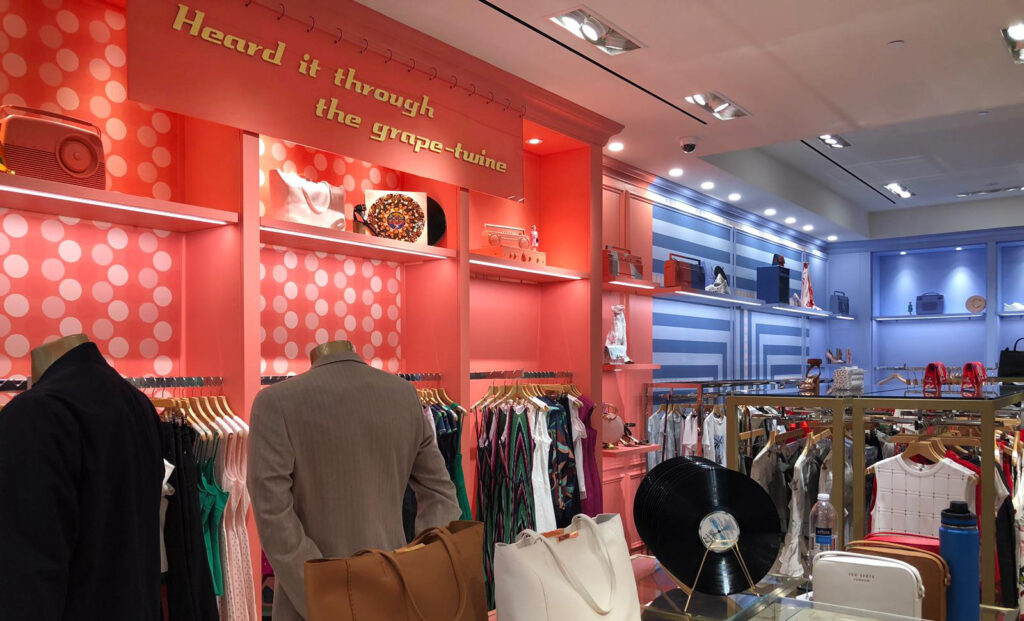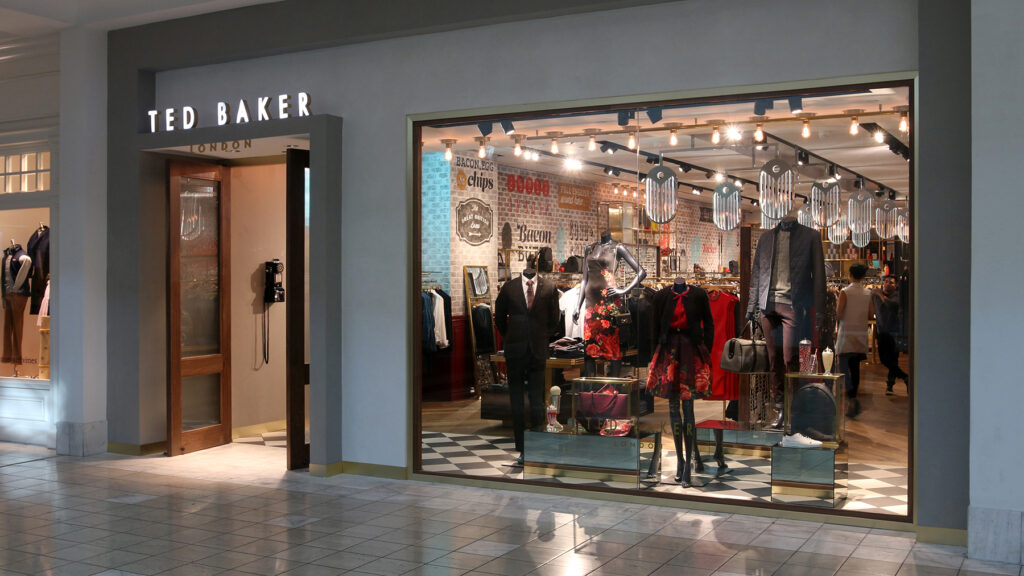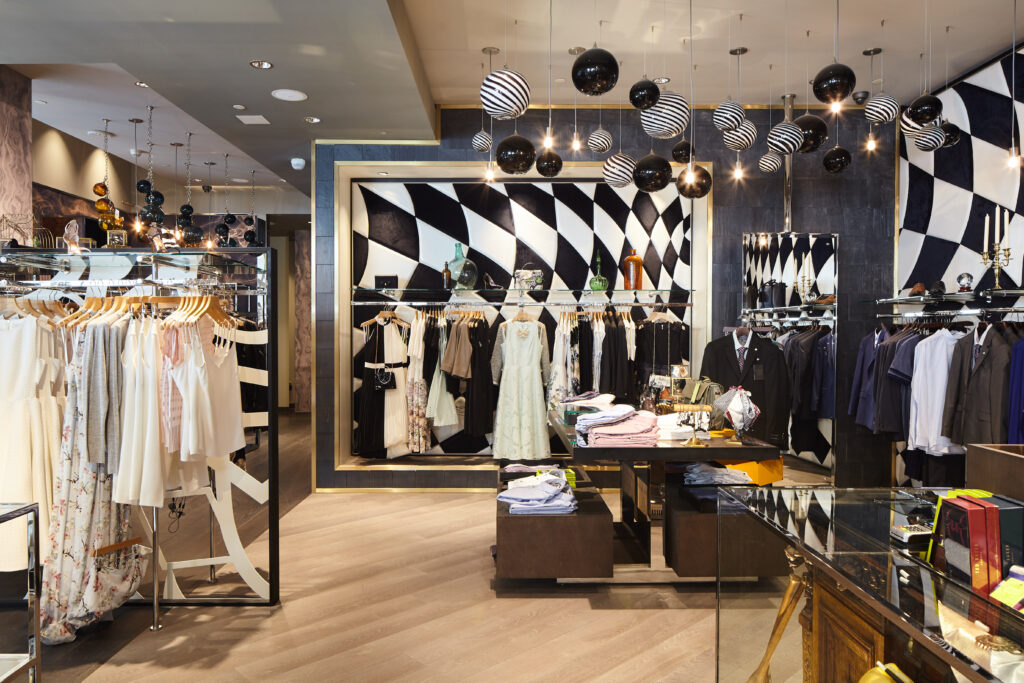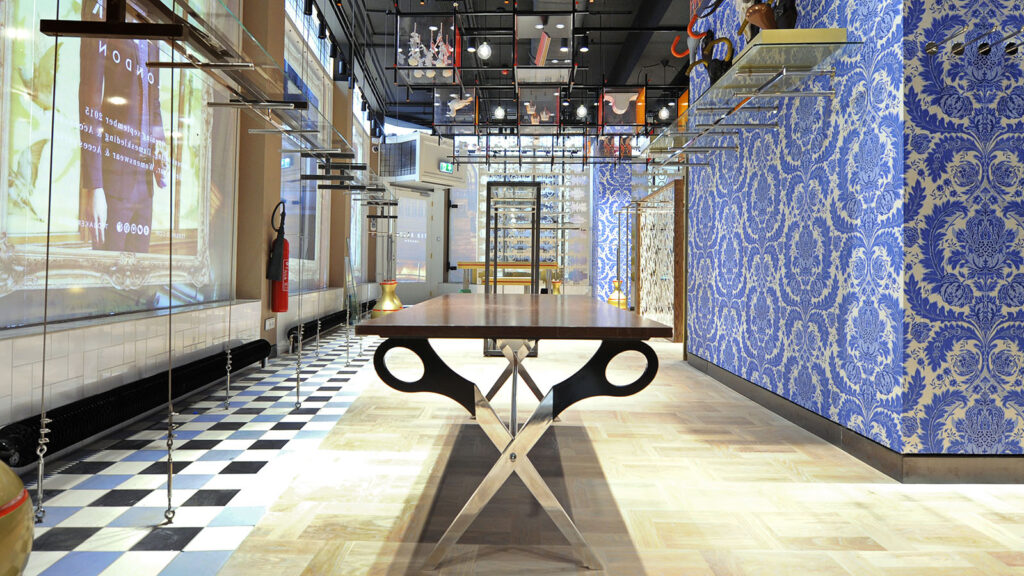Learn why retail millwork and design is key to creating customer connections
Unique community. Authentic relationships. Personalized recommendations. Gathering space. Human connection. Welcoming space. Knowing your customers. Focusing on what you do best. Local feel. Engaged employees.
This is Barnes & Noble. This is Ted Baker. This is Starbucks. This is Warby Parker.
Each of these retailers sells a broad product offering: books, men’s clothing, coffee, sports apparel, and jeans. However, the similarities end there for each brand’s retail locations.
The Ted Baker store in Amsterdam looks and feels different from the Ted Baker store in Detroit. Each of the nine Barnes & Noble stores in New York City has unique product offerings, retail design, and in some cases, logos. And the Starbucks in a small Canadian community offers more seating and quieter music than a bustling urban-core location.
These retailers are using retail millwork design and installation to be more than a store. They are responding to what people really need and crave – personal connection and a feeling of belonging.
Giving people a retail store that resonates with them on an emotional and personal level is how you sell products. And this doesn’t happen when you use the same artwork, shelving, lighting, product displays, and window displays in Anchorage, Alaska and San Diego, California.
Global brands going local is the new era of retail millwork design and installation.
The Evolution of Shopping
People used to want same-same – the same store with the same products, it didn’t matter the location. This was comforting. It helped us belong and feel at ease. But now, we need something more.
Way back in 2006, Harvard Business Review published an article titled Localization: The Revolution in Consumer Markets. These sentences stand out:
Standardization has been a powerful strategy in consumer markets, but it’s reached the point of diminishing returns. Building more of the same—long the cornerstone of retailer growth—seems to be tapped out as a strategy.
When it comes to consumer markets, one size no longer fits all. In response, smart retailers and consumer goods companies are starting to customize their offerings to local markets, rolling out different types of stores, product lines, and alternative approaches to pricing, marketing, staffing, and customer service. They’re moving from standardization to localization.
Fast forward to 2016, where a Modern Retail article highlights the push for hyper-localization and the importance of knowing consumers.
There’s arguably no better example of hyper-localization than one of the biggest local-store success stories of the current retail era: the surprising survival and even revival of the independent bookstore. While bookstores were once written off as Amazon’s first victims, in recent years, new bookstore openings have outpaced closings.
Despite their inability to compete on price, local bookstores have thrived at finding ways to appeal to customers. Shoppers see an advantage not just in browsing amid actual books, but also in turning to staff for recommendations and general chit-chat.
And now here we are in 2023 in a brand new retail landscape transformed by the collision of the pandemic and the boom in online and DTC retail. The pandemic caused consumers to re-evaluate why they shop in brick-and-mortar stores, especially in an era where everything is available online.
Smart retailers realize that stores need to be different now. They need to be spaces where people feel seen, accepted, and welcomed. The shopping is almost secondary.
Experiences. Conversations. Entertainment. Product demos. Help. Connection. This is why people walk into stores now. And this cannot happen with old-school retail design. Your millwork, window displays, graphics, and layout need to focus on the consumer. Your products are no longer enough. It is all about the consumer now.
A mom chooses a local skateboard shop instead of an online website, even though the prices are cheaper online. What matters to her is getting first-hand advice about wheels and grip tape – so she can be confident she is buying her teenager what they want. The sales staff spend lots of time with her, explain the differences between products, and even convince her not to buy the most expensive wheels. This mom leaves the store feeling happy about her purchase and recommends the store to her friends – she tells them she trusts the skateboard shop.
To keep pace with this shopping evolution, your millwork, graphics, window displays, layout, and entire visual merchandising strategy needs to adapt. What used to work, no longer does. (Just scan the headlines about big-box store closures…)
Creating a Localized and Personalized Retail Store Design
Target, Tesco, Walmart, Best Buy, and J.C. Penney. These are just a few of the retailers who failed to recognize the importance of knowing their consumers.
Each of these companies forgot that people are not the same. Everyone has unique needs, preferences, and shopping habits.
What works in one country, city, or neighborhood cannot be standardized and repeated. The good news is that retailers including Barnes & Noble, Kohl’s, Nike, Ted Baker, Warby Parker, and Starbucks understand this.
Be like these brands and use millwork, window displays, graphics, layout, lighting, and retail installation to resonate with your local consumers.
- Personality: consumers want to connect with your mission and vision. Use retail design elements such as window displays, graphics and signage, and floor layouts to tell your story. Remember that this story needs to be different in Burlington, Vermont and Houston, Texas.
- Local Flair: collaborate with local designers, artists, community groups, and suppliers to bring the community into the store. Showcase local products near the entrance using millwork such as gondolas, display cases, and shelving. Consider a community corner highlighting community events and in-store collaborations. Host pop-ups with local makers and suppliers.
- Customization: choose your products carefully, ensure they resonate with what people in the community need. Know the issues and demands in the community and curate your products to reflect this. Incorporating millwork such as adjustable shelving units, slatwalls and pegboards, or modular panels makes it easier for you to update your product displays quickly and effectively.
- Connection: know who your consumers are and why they are interested in your brand. Are they looking for personalized product recommendations? Are they seeking out subject matter experts? Do you have customers who are new to your niche and need in-store demos, training, or workshops? Do they want a space that lets them slow down and browse without feeling bombarded by products and signage? Your retail millwork, graphics, lighting, and fixtures should support these consumer expectations.
- Community: where are you located – urban, suburban, rural, or somewhere in-between? What is your competitive advantage and appeal for this location? Emphasize this with your window displays, millwork installations, store layout, and pop-up collaborations. Make it obvious why you are different, better, and the right choice for consumers.
Consider these four different Ted Baker window displays. Every Ted Baker store has a unique personality and retail design tailored to its location and customer demographic.




Retail Design and Installation for Real People
It’s no secret there is a loneliness epidemic, and people visit retail stores for more than shopping – they want to feel part of and belong to something.
So give it to them.
- Demo and tester kiosks that let people see and feel how your products fit into their lives and solve their challenges.
- Display cases and shelving units that can be adjusted and customized to showcase seasonal items.
- Mannequins and forms that look like your customers.
- Floor layouts and signage that make it easy for people to move around, relax, and find what they needs.
- Window displays that communicate how your brand mission and ethos meshes with the community.
- Pop-up collaborations with adjacent brands or local artisans.
- Accessible and knowledge sales personnel who can educate and support consumers, giving them the extra information they need to feel confident about their purchase.
You’re not selling to a data point on a spreadsheet.
You’re selling to humans, people with emotions, challenges, and history. Remember this – your retail success depends on it.
(Just ask James Daunt…)
At Dynamic, our unique combination of IN-HOUSE offerings makes us your single source provider for retail millwork design and installation, graphics, and window displays. No one understands retail design and installation better than we do.
You need our network of highly skilled local retail designers, fixture installers, and service providers. Real people who know your local market. Our strength is our people.
Contact us to learn how we can handle any aspect of your business – from an individual installation to a global roll-out.
